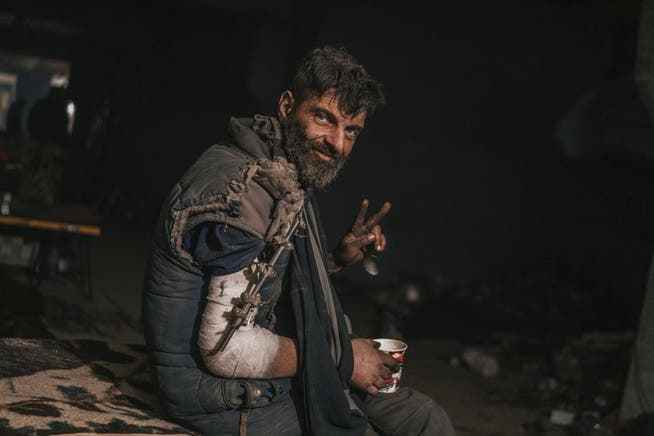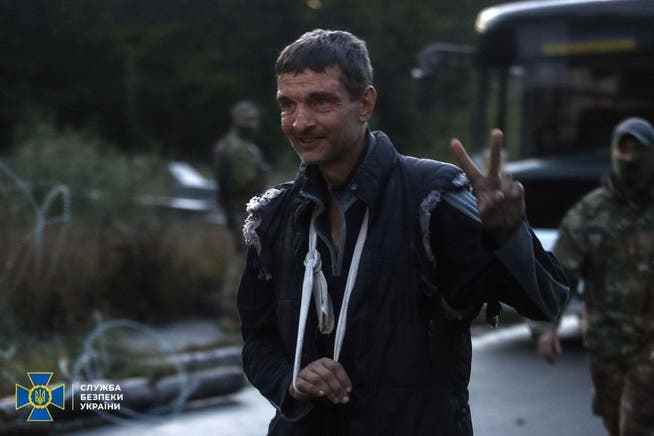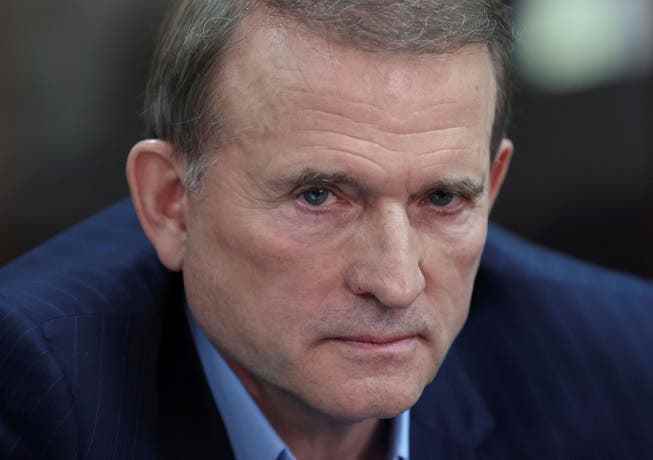The liberation of nearly 200 Azovstal defenders is a triumph for Kyiv and thwarts Russia’s plans for a show trial. The Moscow propaganda reacted tight-lipped – probably with good reason.
Kirilo Budanov, the head of Ukraine’s military intelligence, with three released commanders of the Azovstal defenses.
While world public attention was focused on the partial Russian mobilization on Wednesday, the warring parties carried out a spectacular exchange of prisoners on the same day. Moscow let 215 enemy soldiers free, among them 10 foreigners who had fought on the Ukrainian side. In return, Kyiv handed over 55 Russians and a Ukrainian businessman and politician close to Putin. Reports that another 32 invaders will soon return home have not been confirmed for the time being.
The fact that 108 fighters from the Azov regiment are also part of the exchange makes it a triumph for Kyiv. Russia has consistently portrayed the formation, which is part of the National Guard and originally hailed from the far-right milieu, as epitomizing the supposedly “Nazi” character of official Ukraine as a whole. Again and again the Kremlin and its aides in the separatist “people’s republics” announced plans for public show trials in the occupied city of Mariupol. The fact that some of the fighters had been sentenced to death made the exchange very difficult, said President Zelenskiy.
Defensive combat symbols
A total of 188 defenders of the Azovstal Steel Works were released. Among them are five commanders of the bloody battles: Officers such as Denis Prokopenko and Sviatoslav Palamar are considered heroes in the Ukraine, who held out for weeks under inhumane conditions against Russian superiority and thus tied down large enemy forces in Mariupol. Pictures of wounded fighters like Michailo Dianow, who was also released on Wednesday, caused dismay around the world. For four months, the families of the fighters demonstrated in front of the government headquarters in Kyiv and abroad for their release from Russian captivity.


Mikhail Dianov during the siege of the Azovstal plant (above) and after his release.
The attack on a building housing Azov prisoners of war in Olenivka at the end of July, which was allegedly orchestrated by Russia and killed 53, lent their fate additional emotional explosiveness. Among those who have now been released are 8 wounded from this camp. The fact that Selenski was able to announce a total of “215 good news” on Wednesday also relieves him domestically. According to the Ukrainian secret service, a total of 802 prisoners have been exchanged in 20 operations of this type since the beginning of the war.
The exchange came about through the mediation of Recep Tayyip Erdogan. He also guarantees that the five commanders will no longer be able to intervene directly in future battles: they will remain in Turkey under the care of the President until the end of the war.
Saudi Arabia also played a role, with the kingdom handling the transfer of 10 foreign fighters, including 2 Americans and 5 British. They played a central role in Russian propaganda, as their presence supposedly proved that “foreign mercenaries” were pulling the strings behind the Ukrainians. They were denied the status of prisoners of war and their fate was uncertain until they were released.
“Terrorists” vs. “Traitors”
The official Moscow channels reported the prisoner exchange only very briefly. The fact that this came about on the day of the partial mobilization and thus received less attention than normal may well have suited the Kremlin. The Ministry of Defense confirmed it with a delay on Thursday. However, it did not address the fact that the number of Ukrainians released was significantly higher than that of the Russians, nor the fact that among them were fighters from the Azov battalion.
The news, however, caused consternation among nationalist bloggers. Many wondered why the Kremlin was mobilizing reservists on the one hand and releasing “terrorists” on the other. The fact that the Kremlin exchanged the pro-Russian politician Viktor Medvedchuk for 200 soldiers caused particular outrage. He was in prison in Ukraine.
The Ukrainian secret service accuses the former MP of illegal dealings with the separatists and the disclosure of state secrets. According to unconfirmed reports, Putin is said to be the godfather of Medvedchuk’s daughter. He seems to have much more value for the Kremlin ruler than for the Ukrainians. They emphasize that he shared all the useful information he had with prosecutors during the course of the proceedings.

Rumor has it that Vladimir Putin is the godfather of Viktor Medvedchuk’s daughter.
Meanwhile, President Erdogan was convinced that the prisoner exchange was a big step towards the end of the war. However, Ukraine pointed out that more than 2,000 defenders from Mariupol alone were still in Russian custody. Statistics on the total number of prisoners of war on both sides do not exist. The UN and the Red Cross have long complained about the insufficient access to the camps – especially on the Russian side.
